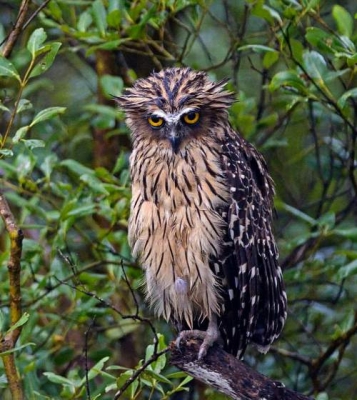
The buffy fish owl, or Ketupa ketupu, is a medium to fairly large owl which belongs to the family Strigidae. As its name would suggest, this fish owl is found near fish-bearing waters, often close to human habitation. It also inhabits tropical forests and freshwater wetlands such as mangroves as well as coastal areas covered with foliage. These owls are found in the eastern states of India, Bangladesh, Thailand, the Malay Peninsula, Sumatra, Java and Borneo.
It is a brown bird with tawny brown feathers on its back and a light-brown face with pale eye-brows. It has prominent ear tufts on the sides of its head and its wing and tail feathers are broadly barred with yellow and dark brown. Its long legs are not feathered and its beak is between its eyes rather than below it, giving it a somewhat glum expression! Its facial disc is undefined, indicating that this owl does not depend much on sound for its hunting (the deeper and more prominent the facial disc, the more acute the hearing of the owl).
Its diet consists mainly of fish, crabs, rats, mice, reptiles, frogs, toads and insects. It hunts from a perch, usually at the water’s edge or from a wooded bank, swooping down to catch prey just under the water’s surface. It will also wade in shallow streams looking for crabs, frogs and fish. It is persecuted by local fisherfolk because it will also hunt farmed pond fish.
It prefers to nest in the fork of a thick tree with adequate green cover and also in tree hollows and caves. It will also use the nests of other raptors when available. It usually lays one or two dull, white eggs and incubation lasts between 28 and 29 days. This bird species is listed under ‘Least Concern’ on the IUCN Red List.
Picture Credit : Google




